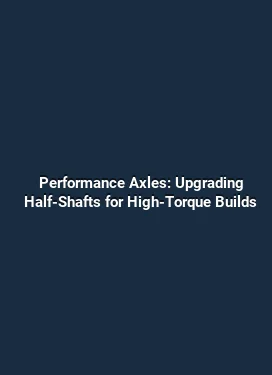Best Torque Converter Stall Speed for Automatic Transmission Cars
Torque converter stall speed is a critical parameter for automatic transmission vehicles, influencing how quickly a car launches, how it responds under load, and how the drivetrain handles different driving scenarios. Understanding stall speed helps enthusiasts optimize performance, improve launch consistency, and tailor a vehicle’s behavior to specific applications, from daily driving to competitive events. Rather than treating stall speed as a vague specification, this guide delves into the physics, measurement methods, and practical tuning approaches that yield measurable results on the road and track.
Foundations: What Stall Speed Really Indicates

Stall speed refers to the engine RPM at which the torque converter begins to transmit a meaningful amount of torque to the transmission input shaft. Below stall, the converter acts like a fluid coupling, slipping and absorbing energy without moving the drivetrain effectively. Above stall, the converter locks up more efficiently with the engine torque, delivering power with less slippage and better throttle response. The exact stall speed depends on several factors, including the converter design, transmission gear ratios, engine torque curve, and fluid properties inside the torque converter.
In practical terms, a lower stall speed tends to improve driveability at low RPM, giving smoother off-idle response and better engagement in stop-and-go traffic. A higher stall speed, conversely, can enhance launch performance in racing or heavy-tow situations by allowing the engine to stay in a higher torque region under load before the converter starts transmitting power efficiently. Selecting the right stall requires balancing everyday usability with the intended performance goals.
Key Variables That Shape Stall Speed
Several intertwined variables determine the effective stall speed of a torque converter setup:
- Converter Design and Stator Configuration: A higher stall converter typically uses a torque multiplication approach that favors sharp response at the expense of idle efficiency. The stator geometry, turbine fins, and internal clearances all influence when the converter transitions from slipping to transmitting.
- Engine Torque Curve and Dyno-Tuned Power Band: The engine’s peak torque region and how that torque is delivered across RPMs will shift the practical stall point. Engines with broad torque curves may see different stall behavior compared to high-revving setups.
- Transmission Gear Ratios: Gear ratios constrain where the engine RPM sits under launch. A taller (numerically lower) final drive reduces engine RPM at a given road speed, potentially requiring a higher stall to achieve a strong launch.
- Hydraulic Fluid Dynamics: Fluid viscosity, temperature, and quality affect slip characteristics. Warmer fluid lowers resistance, which can shift stall slightly higher, while thick fluid can do the opposite.
- Clutch and Lock-Up Behavior: Some converters employ lock-up mechanisms that engage at certain RPMs. The interaction between slip and lock-up determines the effective stall range you experience during acceleration.
Understanding these factors helps in diagnosing why a particular stall speed feels different from advertised numbers, and why two cars with seemingly similar specifications can behave differently in real-world conditions.
Measuring Stall Speed: How to Verify Your Setup
Accurate stall speed testing requires controlled conditions and careful observation. Start with a full-throttle pull in a suitable gear (often the lowest practical gear) and monitor engine RPM at the moment when the drivetrain begins to move the vehicle with minimal tire slip. In a controlled environment, you can isolate variables by testing at constant ambient temperature and road surface conditions. A data-logging setup with a tachometer and a transmission input shaft sensor can provide precise readings, reducing the guesswork associated with seat-of-the-pants assessments.
Another practical method involves calculating stall from wheel speed and engine RPM once the vehicle breaks traction momentarily. This approach, while less precise than direct measurement, offers real-world insight for street-driven cars. In either case, ensure the vehicle is safe, the surface is grippy, and shifts remain reliable during the test to avoid drivetrain damage.
Choosing the Right Stall Speed for Different Applications
Stall speed selection should align with the vehicle’s primary use-case. The following scenarios illustrate how different targets influence tuning decisions:
Daily Driving and Streetable Performance

For commuter cars and street performers, a moderate stall that emphasizes low-end response without sacrificing drivability is ideal. The goal is to minimize off-idle lag while keeping transmission lines stable in stop-and-go traffic. In this context, a stall associated with comfortable acceleration at low engine RPMs reduces engine lugging and improves throttle feel during light-to-moderate throttle inputs.
Practical tips include ensuring the converter fluid remains within the optimal temperature range and avoiding overly aggressive stall designs that elevate transmission heat under urban driving conditions. Regular maintenance, including transmission fluid changes and cooler upgrades if needed, supports consistent performance over time.
High-Performance Street and Light Competition
Vehicles used for spirited street driving or drag-oriented street events benefit from a higher stall that keeps the engine in a robust torque region under launch. The objective is to maximize bite-off-the-line without subjecting the drivetrain to excessive heat. These setups often pair a converter with moderate torque multiplication and carefully matched gear ratios to preserve drivetrain longevity while delivering a strong launch and clean upshift behavior.
When selecting a higher stall, it is important to monitor fuel economy and transmission heat, as higher slip at launch can translate into increased thermal load. Upgrading the transmission’s cooling capacity and ensuring the exhaust and intake systems support efficient breathing can help maintain reliability.
Racing and Heavy-Tow Applications
In competitive settings or with substantial towing demands, stall speed targets shift upward to leverage maximum torque at launch. The higher stall allows the engine to operate in a high-torque region for longer before the converter starts transmitting power efficiently, resulting in faster and more consistent launches under load. However, this often requires additional cooling, precise engine calibration, and sometimes a more aggressive torque converter with reinforced internals to manage added stress.
In practice, teams frequently pair high-stall converters with advanced fuel and ignition strategies, as well as data-driven tuning to ensure the engine remains within safe operating limits across a range of track conditions and payloads.
Practical Tuning Steps: From Assessment to Optimization
Moving from theory to practice involves a systematic approach to tuning stall speed while preserving reliability. The following steps outline a practical workflow:
- Baseline Assessment: Document the current stall behavior using a controlled launch test and record engine RPM, wheel speed, and vehicle weight. Note how heat affects performance across repeated launches.
- Define Objectives: Clarify whether the goal is quicker off-idle response, higher trap speeds, or better daily drivability. Clear objectives steer the choice of converter and supporting components.
- Gear Ratio and Tire Considerations: Revisit final drive ratio and tire size, as these influence RPM at launch. Adjust expectations accordingly to avoid overestimating the potential gains from a higher stall.
- Cooling Upgrades: If higher stall leads to increased heat, install or upgrade transmission cooling and consider a dedicated cooler circuit to maintain fluid temperatures within a safe range.
- Fluid and Filtration: Use high-quality transmission fluid with appropriate viscosity and heat tolerance. Regular fluid changes help maintain consistent slip characteristics across temperatures.
- Monitoring and Tuning: Use data logging to correlate engine RPM, torque output, and transmission input shaft speed during launches. Fine-tune with incremental changes to stall characteristics and lock-up behavior as needed.
In all steps, prioritize drivetrain safety and verify that the transmission’s gears, clutches, and valve body respond reliably under the chosen stall conditions. Progressive testing minimizes risk while revealing the true performance potential of the setup.
Common Wiring and Setup Considerations for Modern Automatics
Modern automatic transmissions may incorporate electronic control strategies that influence stall behavior. Several practical considerations include:
- Valve Body Calibration: Transmission control modules (TCMs) may adjust line pressure and shift points in response to engine load. Ensuring compatibility between the converter and the TCM calibration helps prevent undesirable shifts or slip during launch.
- Lock-Up Strategies: Some converters employ programmable lock-up strategies that engage at specific RPM and load thresholds. Understanding how lock-up interacts with slip can help optimize effective stall and efficiency.
- Exhaust Backpressure and Airflow: Adequate exhaust flow reduces engine backpressure, allowing the engine to reach torque peaks more cleanly, which in turn affects the perceived stall performance.
- Diagnostics: Regular diagnostics with specialized tools can reveal clogs, worn valve bodies, or inconsistent pump pressures that mimic stall issues, making accurate assessment essential.
These considerations highlight why a holistic approach—balancing converter selection with engine calibration, cooling, and electronic control—produces the most reliable and predictable results across driving conditions.
Real-World Scenarios: Case Studies and Examples
Consider a street-focused V8 with a modest rear axle ratio and a converter designed for a mid-range stall. In daily driving, the car responds crisply to throttle input from a stop, yet remains comfortable on the highway due to sensible lock-up behavior. In a quarter-mile test, the same setup yields a strong initial launch while maintaining stable transmission temperatures under the strain of repeated passes. Such outcomes demonstrate how thoughtful stall speed selection translates into tangible benefits across diverse scenarios.
In another example, a sports-oriented turbocharged four-cylinder uses a high-stall converter to keep the engine in a high-torque zone during launches on a sticky surface. The result is quicker reaction time and a higher trap speed, but the owner manages heat generation with an upgraded intercooler and an additional transmission cooler to preserve consistency across multiple runs.
Maintenance and Longevity: Keeping the System Healthy
Preserving the benefits of a well-chosen stall speed requires disciplined maintenance. Regular fluid checks, timely changes with the correct specification, and a properly sized cooler are fundamental. Heat is the primary adversary of automatic transmissions and torque converters; effective cooling directly impacts slip characteristics and overall reliability. For high-stall configurations, consider monitoring fluid temperatures during launches and implementing a data-driven maintenance schedule to prevent degradation over time.
Additionally, ensure that engine and transmission mounts remain in good condition. Excess movement can alter alignment and load distribution, subtly affecting stall behavior over time. A well-aligned drivetrain reduces unintended slip and wear, contributing to consistent performance gains from stall speed optimization.
Conclusion: Integrating Stall Speed Strategy into Overall Performance
While stall speed is a critical lever for improving launch quality and response, its value is maximized when integrated with a broader performance strategy. Matching engine power, drivetrain components, cooling, and electronics creates a cohesive system that delivers the intended behavior in real-world driving, not just on paper. The art of choosing and tuning stall speed lies in balancing immediate performance with long-term reliability, ensuring that every launch, every shift, and every acceleration event aligns with the vehicle’s intended use.






